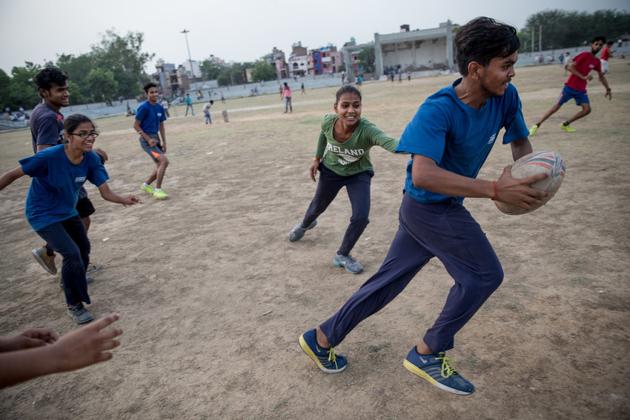In a slum in New Delhi, a group of young women and men are making their city safer
 Playing together teaches the team respect for each other. It breaks stereotypes. And it teaches the players that public spaces belong to all.(NAMITA BHANDARE)
Playing together teaches the team respect for each other. It breaks stereotypes. And it teaches the players that public spaces belong to all.(NAMITA BHANDARE)
A quiet revolution brews in a narrow lane in one of Delhi’s most unsafe localities. In Mangolpuri, a locality that registers the most number of police cases, a group of young men and women have taken charge of making their neighbourhood safer. Do streetlights work? Are there enough CCTVs? How do you rid the community park of drug addicts and gamblers who gather here after sundown?
Supported by a set of non-governmental organisations, over 500 young people who live here have conducted safety audits and taken up their concerns with the police, transport and public works department. Their goal? To build safe, accountable and inclusive cities for adolescent girls.
“In this locality, girls could not go out. On the streets, boys hung out in groups and would pass comments,” says Sonia, 14, a class 10 student. Adds Komal, 21, a graduate who is now learning stenography, “The only place I felt safe was within the four walls of my house.” In 2014, the Safer Cities Programme was launched in five cities around the world, including Cairo, Hanoi and Delhi. Two resettlement communities, Mangolpuri and Madanpur Khadar were selected, and by 2018, the programme had touched 80,000 homes in Delhi.
“The idea was to build promising futures for young women,” says Asif Mohammad, executive director, Plan India, one of the organisations involved in the campaign.
Crucial to long-term gender transformation that increases girls’ access and safety to public spaces is to make them stakeholders. But, it was just as crucial to involve boys and young men to “create allies in building safe and enabling environments,” says Mohammad.
One way to do this was to set up youth clubs. In a rented room in a bylane in Mangolpuri, a group of 15 people aged 12 to 25 are talking about safety. This is where the Girls’ Friendly Space club meets everyday to play, read, dance and just talk. “We have a lot of meetings where we talk not only about safety but how to end differences between boys and girls,” says Ankita, 13.
It’s here that the club members learn self-defence, talk about gender equality and why girls need to have equal access to public spaces. Among its activities is touch rugby where boys and girls play together. “Earlier I was uncomfortable to wear shorts and play. Now I don’t care,” says Sapna, 17, a junior player.
Amit,16, who joined the team in 2016 had never played with girls. “They have a lot of attitude. It can be scary,” he laughs. Playing together teaches the team respect for each other. It breaks stereotypes. And it teaches the players that public spaces belong to all.
Can this model be scaled up? Yes, absolutely, says Mohammad. The costs are low and making our cities safer isn’t exactly rocket science. What it needs is will — and a few good men and women.
(The names of minors have been changed.)
Namita Bhandare writes on gender
The views expressed are personal